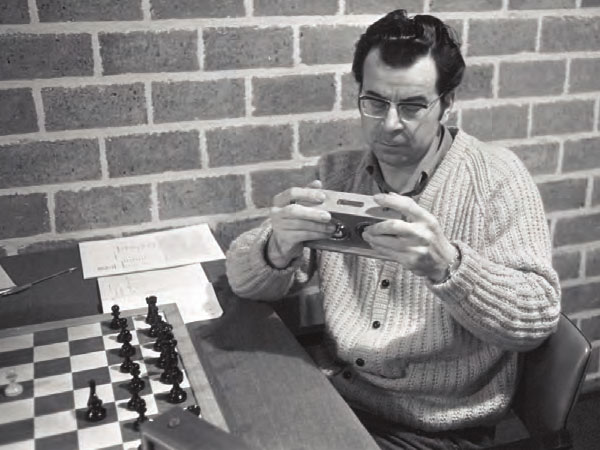


Standard chess mistakes usually occur when a player misses a move or moves available to his adversary. Here we’ll focus on a strange mistake which stems from another source.

[Event "Israel"] [Site "?"] [Date "2016.??.??"] [Round "?"] [White "'G'"] [Black "'A'"] [Result "0-1"] [Annotator "Amatzia Avni"] [SetUp "1"] [FEN "r4rk1/ppp3pp/3p4/3P1p2/5R1q/P3PP2/1P1Q1P1P/2R3K1 b - - 0 18"] [PlyCount "5"] [EventDate "2016.??.??"] [SourceTitle "Chess 2017 #09"] {This position arose in a game between two strong teenage players.} 18... Qh3 { With the obvious threat of 19...Rf6, intending the lethal 20...Rg6+ 21 Kh1 Rh6. White was alert and played} 19. Qe2 ({ready to meet} 19. Qe2 Rf6 {with} 20. Qf1 {.}) 19... Rf7 {Black defends c7 and now White forgot about Black's previous threat, as in his mind the black rook on f7 was destined only to a passive role.} 20. Rcc4 $4 Rf6 {. --- This tragicomic example demonstrates a special kind of blunder. Unlike the common mistake of ignoring the enemy's threats, here a player is aware of his opponent's intentions, but after some time he loses concentration, forgets his previous thoughts, and errs.} 0-1
You probably know that you can move pieces on the replay boards to analyse, and even start an engine to help you. You can maximize the replayer, auto-play, flip the board and even change the piece style in the bar below the board. At the bottom of the notation window on the right there are buttons for editing (delete, promote, cut lines, unannotate, undo, redo) save, play out the position against Fritz and even embed our JavaScript replayer on your web site or blog!

Hovering the mouse over any button will show you its function

[Event "Santa Monica"] [Site "?"] [Date "1966.??.??"] [Round "?"] [White "Unzicker, W."] [Black "Ivkov, B."] [Result "*"] [ECO "B92"] [Annotator "Amatzia Avni"] [SetUp "1"] [FEN "2r1rbk1/1p1n1ppp/pq1pb3/4n3/3NP3/2N3Q1/PPP1B1PP/2BR1R1K w - - 0 18"] [PlyCount "3"] [EventDate "1966.??.??"] [SourceTitle "Chess 2017 #09"] 18. Nf5 {--- Annotating the game, Ivkov reveals that, having foreseen White's threat (19 Rxd6) in advance, he began assessing the consequences of various defences, as 18...Rc6, 18...Bxf5, and 18...g6. Somewhere during his thinking process, he forgot about White's immediate threat and blundered horribly:} Kh8 $4 19. Rxd6 {(1-0, 78).} *

[Event "Leningrad"] [Site "?"] [Date "1932.??.??"] [Round "?"] [White "Chekhover, V."] [Black "Model, A."] [Result "*"] [Annotator "Amatzia Avni"] [SetUp "1"] [FEN "3rr1k1/pp3pp1/4b3/8/2P1B2R/6Q1/P2q2PP/5R1K w - - 0 29"] [PlyCount "7"] [EventDate "1932.??.??"] [SourceTitle "Chess 2017 #09"] 29. h3 ({According to White, a strong player and a prominent study composer, he calculated the variation} 29. Bh7+ Kf8 30. Qa3+ (30. Bg6 $1 {wins}) { , but realised that} 30... Qd6 {grants Black a sufficient defence, so he made 'luft' for his king.}) {Black blundered with 29...Qe2?} 29... Qe2 $2 {and now White's previous idea would have won:} 30. Bh7+ Kf8 31. Qa3+ Re7 32. Bd3 $1 {However, Chekhover forgot to re-examine his previous idea and missed this golden opportunity, the game eventually ending in a draw.} *
Forgetfulness happens in other chess areas too. According to Knotts and Hearst, in 1994 Korchnoi forgot he had just played a certain move in a blindfold game and tried to play it on the computer screen once again on his next move, something that cost him a lot of time and eventually led to his overstepping the time limit.
Tigran Petrosian, in his third matchgame against Fischer held a better position when suddenly his opponent claimed a draw: “For the first time in my life I fell for a threefold repetition... In chess I mainly fear two things: sealing an impossible move in an adjourned game and falling into a threefold repetition with a better position; [...] when Fischer demanded the draw I could not understand what triple repetition he was talking about.”
Also, forgetting one’s preparation is a frequent phenomenon. Especially in the modern era, when there are loads of opening variations to memorise, many players complain that they just couldn’t reconstruct the moves they were rehearsing at home. Mixing up variations happened too (in the old days) in adjournment analysis, even at the highest levels.

[Event "World Championship, Moscow"] [Site "?"] [Date "1958.??.??"] [Round "18"] [White "Botvinnik, M."] [Black "Smyslov, V."] [Result "*"] [ECO "A16"] [Annotator "Amatzia Avni"] [SetUp "1"] [FEN "2R2k2/8/6p1/p3K3/bp3P2/6PB/r6P/8 b - - 0 46"] [PlyCount "10"] [EventDate "1958.??.??"] [SourceTitle "Chess 2017 #09"] {Botvinnik testifies that after the resumption of play, Smyslov was firing off his moves at lightning speed, trying to confuse his rival. Here he should have continued 46...Kg7 or 46...Ke7 with a likely draw; instead, as he sat back down he instantly produced the blunder:} 46... Be8 $4 {"Probably he confused the present position with the one which could have arisen [in a different variation]" - Botvinnik. Black lost after} 47. Bd7 Re2+ 48. Kf6 {(1-0, 74), as} b3 {succumbs to} 49. Rb8 b2 50. Bxe8 Rxe8 51. Rxb2 {.} *
We don’t have an account of the proceedings in the next episode, but we may deduce with a certain degree of confidence what happened from the moves.

[Event "Krasnodar"] [Site "?"] [Date "1995.??.??"] [Round "?"] [White "Mikhailenko, A."] [Black "Savenko, A."] [Result "*"] [Annotator "Amatzia Avni"] [SetUp "1"] [FEN "8/8/5p1p/kp1p1PpP/2pP2P1/2P5/2KB1b2/8 w - - 0 1"] [PlyCount "4"] [EventDate "1995.??.??"] [SourceTitle "Chess 2017 #09"] 1. Bf4 $1 {A great move, intending Bd6-f8.} ({By contrast,} 1. Bxg5 {fails to} fxg5 2. f6 Bg3 3. f7 Bd6 {.}) ({After} 1. Bf4 {, Black can play} b4 ({or the more complicated} 1... gxf4 2. g5 f3 3. g6 Bh4 4. Kd1 f2 5. Ke2 b4 {both of lead to a draw.})) {However, he opted for 1...Bxd4?:} 1... Bxd4 $2 ({The idea was} 1... Bxd4 2. cxd4 gxf4 3. g5 f3 {which wins for Black.}) {Apparently he forgot about 2.Bxg5!:} 2. Bxg5 $1 {What was previously a losing move, is now a winning one!} -- (2... fxg5 {is defeated by} 3. cxd4 {;}) ({and} 2... Be5 3. Bxh6 {is also without hope for Black, as he is behind in the pawn race.}) *
“We often look for and note enemy possibilities before beginning our calculations; but once we get involved in a deep line of analysis, it’s easy to forget our earlier conclusions”
—Bruce Pandolfini
Convinced that the phenomenon is not infrequent, I asked some friends if they encounter such occurrences in their games. This elicited only one response; I suppose most people are not keen on seeing their embarrassing moments in print...

[Event "Israel"] [Site "?"] [Date "2010.??.??"] [Round "?"] [White "Amit, E."] [Black "Blass, U."] [Result "*"] [Annotator "Amatzia Avni"] [SetUp "1"] [FEN "r5k1/p2nq1pp/3Rp3/2p1PrN1/2p2P2/4Q3/P5PP/5RK1 b - - 0 20"] [PlyCount "3"] [EventDate "2010.??.??"] [SourceTitle "Chess 2017 #09"] 20... Raf8 ({"Due to Black's obvious threat after} 20... Raf8 {, I immediately considered} 21. Rfd1 {- so if} Rxf4 ({or} 21... Nxe5 22. Rxe6) 22. Nxe6 { - which would have won."}) {"Suddenly I forgot the threat and played 21.Rxe6"} 21. Rxe6 {"After} Qxg5 {I could have safely resigned", admitted Eli Amit.} *
Sometimes forgetfulness is positive: it’s good if our defeats are not stuck in our long-term memory, so that we can move on. One’s victories should also recede into the background during play. Vishy Anand said in a 2015 interview that his habit of ‘forgetting’ his achievements to keep his motivation intact has contributed immensely to his results.
Ignoring noise, smell or other distractions is also advisable, as is disregarding one’s previous score with our opponent. However, forgetting our plans during a game can hardly be a good thing.

[Event "Curacao Candidates"] [Site "?"] [Date "1962.??.??"] [Round "?"] [White "Fischer, RJ."] [Black "Benko, P."] [Result "*"] [ECO "C13"] [Annotator "Amatzia Avni"] [SetUp "1"] [FEN "r1b2rk1/p5pp/4pb2/1pq2pN1/7P/3B4/PPP1QPP1/2KR3R w - - 0 19"] [PlyCount "5"] [EventDate "1962.??.??"] [SourceTitle "Chess 2017 #09"] {"When I returned (from the restroom) I smiled when I saw that Fischer had played} 19. Nxe6 $2 {falling into (my) trap," writes Benko. "Unthinkingly, and before even sitting down, I grabbed his knight with} Bxe6 $4 ({completely forgetting what I had planned:} 19... Bxb2+ $1 20. Kxb2 Qb4+ 21. Kc1 Qa3+ 22. Kd2 Qa5+ {with a draw, as if} 23. c3 ({or} 23. Ke3 Bxe6) 23... Qxa2+ {wins the material back with advantage."}) 20. Qxe6+ Kh8 21. Kb1 {White won after a further 18 moves.} *

[Event "US Championship, Seattle"] [Site "?"] [Date "2000.??.??"] [Round "?"] [White "Benjamin, Jo"] [Black "Gulko, B."] [Result "0-1"] [ECO "B63"] [Annotator "Amatzia Avni"] [SetUp "1"] [FEN "3r3k/4bp1p/1r3n1P/3pqPB1/1p2P3/pP1B4/P1P3R1/1K1RQ3 w - - 0 28"] [PlyCount "10"] [EventDate "2000.??.??"] [SourceTitle "Chess 2017 #09"] {Black's last move was 27...Qc7-e5, threatening mate on b2. White was alert and defended with} 28. Bc1 {and play continued} dxe4 29. Bc4 Rxd1 30. Qxd1 e3 31. Qg1 Rb8 {Now Joel Benjamin forgot what he was clearly aware of, several moves earlier, and played:} 32. Bxe3 $4 Qb2# 0-1
I will presume that a lot of readers are seeking the practical point of this article, i.e. what they have to do to minimise such errors in their games. As the game develops, before each move one has to constantly go back and rehearse prior calculations and previous conclusions. More broadly, any solution lies in maintaining a high level of concentration. Elaborating on ways of achieving this, I shall leave to other writers.
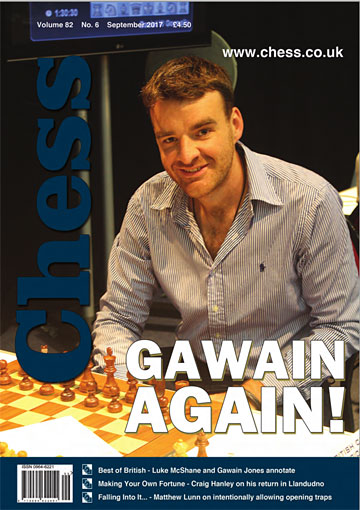
The above article was reproduced from Chess Magazine September, 2017, with kind permission.
CHESS Magazine was established in 1935 by B.H. Wood who ran it for over fifty years. It is published each month by the London Chess Centre and is edited by IM Richard Palliser and Matt Read.
The Executive Editor is Malcolm Pein, who organises the London Chess Classic.
CHESS is mailed to subscribers in over 50 countries. You can subscribe from Europe and Asia at a specially discounted rate for first timers, or from North America.
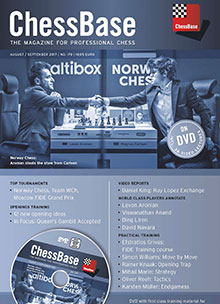 |
ChessBase Magazine 179 The latest edition of CBM is for ‘August/September 2017’ and has a special focus on the main events of June: Norway Chess and the World Team Championship. Elsewhere there are the usual opening surveys, as well as video contributions by Daniel King and Simon Williams, the former taking a look at how to meet the Exchange Lopez. Order online from |
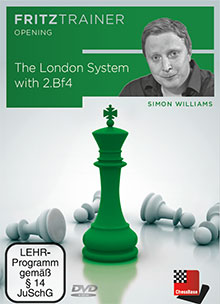 |
The London System with 2.Bf4 ‘Why bother learning hundreds of complex variations and keeping up with the latest theory when you can play a simple yet deadly opening - the London System with 2.Bf4. In this DVD I take you through all the main ideas and setups that you need in order to gain a very exciting yet well founded opening game with the White pieces. The most important thing in my teaching is to keep things simple yet aggressive. This DVD concentrates on plans that will help you gain victory quickly. A perfect opening for the player with little time on his hands. Carlsen has started to play this opening regularly, now I share his secrets with you. Order online from |
 |
Reti: A Repertoire for White 1 Nf3 followed by 2 c4 is, of course, by no means a new development, but it has been quite topical of late and might just surprise many opponents at club level. Bologan is certainly keen on emphasising the typical plans and motifs for White, as he takes the viewer through some 30 mini video lectures. The Symmetrical English lines after 1 Nf3 c5 2 c4 Nf6 3 Nc3 can certainly become quite theoretical, but here and with 1 Nf3 d5 2 c4 c6 3 g3 there should be sufficient coverage for most viewers. Bologan admits that he has not covered quite every black defence, which is honest and shouldn’t be too big a deterent to getting the viewer up and running with 1 Nf3, but quite possibly not all will want to meet the King’s Indian, 1...Nf6 2 c4 g6, with 3 b4!?. Order online from |
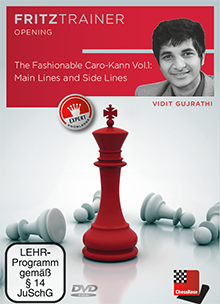 |
The Fashionable Caro-Kann Vol. 1: Main Lines and Side Lines The Caro Kann is a very tricky opening. Black’s play is based on controlling and fighting for key light squares. It is a line which was very fashionable in late 90s and early 2000s due to the successes of greats like Karpov, Anand, Dreev etc. Recently due to strong engines lot of key developments have been made and some new lines have been introduced, while others have been refuted altogether. "I have analyzed the new trends carefully and found some new ideas for Black. I have suggested the lines which I personally prefer and employ in practice." Order online from |
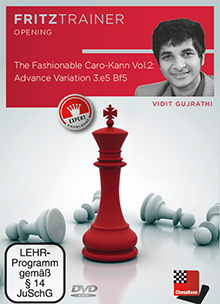 |
The Fashionable Caro-Kann Vol. 2: Advance Variation 3.e5 Bf5 The top player from India completes his repoertoire for Black against 1.e4 with the Caro-Kann Advance Variation. Look forward to an intensive and exciting training course with many new idear that the author has successfully applied against world-class players himself. "I used many of them with great success, managing to score important wins over top GMs Vachier Lagrave, Radjabov, Jobava and drawing against Vishy Anand. I am sure you will learn a lot about the opening!" Order online from |
 |
Rocket Repertoire: The Four Knights The popular English Grandmaster isn’t a man one associates with dull positions, so that he considers 1 e4 e5 2 Nf3 Nc6 3 Nc3 N f6 to be quite a viable position as White makes one sit up and take notice. Williams covers both 4 Bb5 and 4 d4 exd4 5 Nxd4, two sensible options where he does his best to avoid excessive theory and to inject an attacking bent where possible. Unsurprisingly, though, some of the recommendations are still quite positional, something which one couldn’t describe the concluding Belgrade Gambit (4 d4 exd4 5 Nd5!?) coverage as. Order online from |
 |
Powerplay 25: Popular Queen’s Pawn Openings Openings such as the London System and the Trompowsky, once considered side lines, are now just as common in the professional game as at club level. White aims to avoid complex theoretical lines and to start from a solid basis. Yet these openings are not without bite. On this DVD, Grandmaster Daniel King presents a repertoire for Black allowing you to face these systems with confidence. The aim of these recommendations is to come out of the opening with sound development, a sound pawn structure, a secure king, and a dynamic position that gives winning chances. Order online from |
You can also find these products in the ChessBase Shop